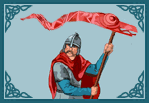 |
 |
|||
|
|
Tristan or Drustan is an
historical figure who appears on a Dark Age inscribed memorial stone
located near the similarly dated lordly residence at Castle Dore, near Fowey. The
inscription reads: "Drustans hic iacit Cvnowori filivs" - Drustan
lies here, the son of Cunomor. The father, Cumomor,
would appear to be the 5th century King of Dumnonia of that name.
Arthurian literature, perhaps embodying some earlier
traditions, tells us that 'Sir Tristram'
was the son of King Meliodas of Lyonesse
and his wife, Isabelle, the sister of King Mark
of Kernow (Cornwall). While a line in the 'Life' of St. Paul Aurelian
identifies the historic Tristan's father, Cunomor, with the more legendary
man's uncle, Mark. This suggests that there was understood to be some relationship
between Tristram of legend and Drustan of the stone, although Mark is traditionally
placed some generations beyond Cunomor. Drustan's position in Cornwall is uncertain. Since Tristram's
traditional kingdom of Lyonesse, an extension of the Isles of Scilly, is almost
certainly mythological, it is possible that he was a sub-ruler of Powder. Despite a number of Tristan related sites having been identified in the West Country, some historians believe that his story has been transferred to Cornwall from Northern Britain. Lyonesse, in its earliest form, appears as Liones, a name very similar to early forms of Lothian in Scotland. As shown by the Cornish stone, Tristan is a form of the Pictish name, Drustan, and a Pictish Prince named Drustan ipe Talorg appears in Welsh records as an early 5th century maternal ancestor of the Kings of Gwynedd. The family originally hailed from Manau Gododdin around Clackmannan in Scotland. According to literary tradition, Tristan had a number of children by his lover, the Fair Isolde, but was married to Isolde the White-Handed, daughter of Hoel Mawr (the Great) of Cornouaille. He was supposedly succeeded in Lyonesse or wherever he ruled by his son, Tristan the Younger. Drustan's memorial stone dates from the 5th or 6th century & clearly shows him to be historic.
|
|||
| © Nash Ford Publishing 2001. All Rights Reserved. | ||||




